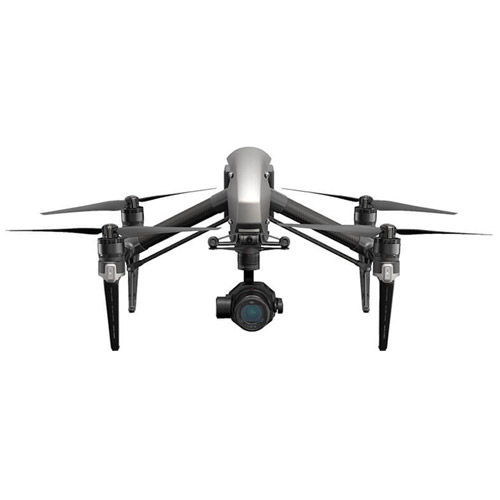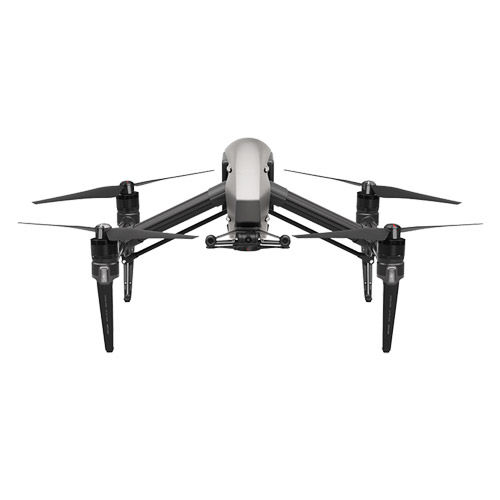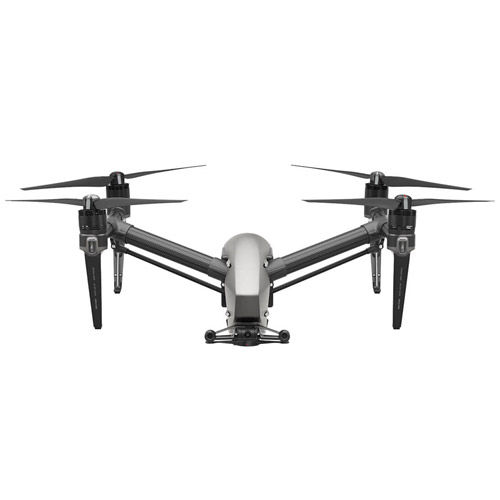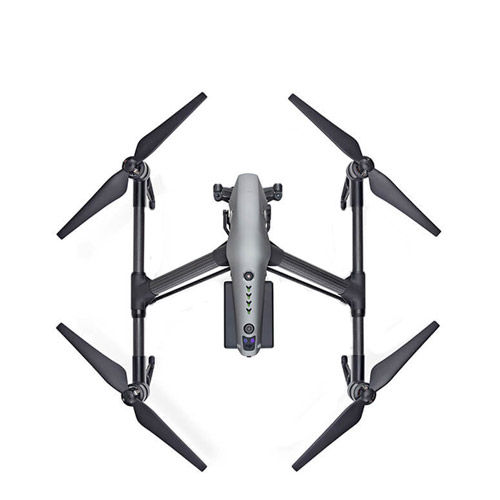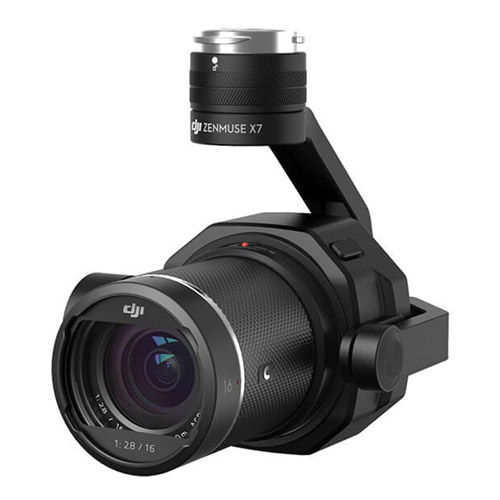- Webcode: 442452 • Mfr: 65170478
Product Highlights
- Super35 Camera Zenmuse X7 Gimbal
- 27 mins Max. Flight Time
- 94 kmph (58 mph) Max. Speed
- 7 km (4.3 mi) Transmission Distance
- 24 MP CMOS Sensor
- 2.4-5.8 GHz Signal Frequency
- 40° Max. Tilt Angle
- Includes Inspire 2, Zenmuse X7 Gimbal & 16mm ASPH ND Lens
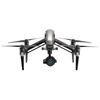
DJI Inspire 2 Advanced Kit with Zenmuse X7 Gimbal & 16mm/2.8 ASPH ND Lens
DJI Inspire 2 Advanced Kit with Ze...- Toronto Special Order
- Ottawa Special Order
- Mississauga Special Order
- Calgary Special Order
- Edmonton Special Order
Overview
Inspire 2
Power Beyond Imagination
The Inspire 1 was a revelation. The first filmmaking drone in the world to integrate an HD video transmission system, 360 rotating gimbal & a 4K camera, as well as the simplicity of app control.
Key Features:
- 23-27 mins Flight Time
- 7 km (4.3 mi) Control Range
- 30 m (98.4') Sensory Range
- 94 kmph ( mph) Speed
- 6K/5.2K Video Resolution
- 1080P Live View
The launches of the Zenmuse X5 & X5R cameras further cemented the Inspire as a critical tool for filmmakers around the globe. The Inspire 2 takes everything that was good about the Inspire 1 & improves it.
An all-new image processing system records at up to 5.2K in CinemaDNG RAW, Apple ProRes & more. It goes from 0 to 50 mph (80 kmph) in just 5 seconds & hits a max. speed of 58 mph (80 kmph). It also has a max. descent speed of 9m/s for unheard of speed & agility in an aircraft this size.
A dual battery system prolongs the flight time to a max. of 27 minutes (with an X4S), which self-heating technology allows it to fly even in low temperatures. Flight Autonomy has been revised and developed specifically for the Inspire 2, providing two directions of obstacle avoidance & sensor redundancy.
Increased intelligence adds multiple intelligent flight modes including Spotlight Pro, which gives even single pilots the ability to create complex, dramatic shots. An upgraded video transmission system is now capable of dual signal frequency & dual channel, which enables simultaneous streaming of video from an onboard FPV camera & the main camera for better pilot & camera operator collaboration.
Aircraft
- Structure: Magnesium, aluminum composite shell & transforming design with carbon fibre arms.
- Configuration: Vision sensing, 2-axis FPV camera, range of supported cameras.
- Propulsion: 58 mph(94 kmph) max. speed, 2 kg thrush per rotor, 15" props, max. 27 min flight time (w/X4S).
- Battery: Dual battery, self-heating, battery redundancy, 98 Wh
Image System
- Image Processing & storage: 5.2K @ 4.2 Gbps RAW video recording, CineCore 2.0, integrated DJI CineSSD.
- Video Format: CinemaDNG & Apple ProRes 5.2K video support, H.265 & H.264 video codec support, 4K video at 100 Mbps. Recorded video can be stored simultaneously on the DJI CineSSD & a Micro-SD card.
- File System: FAT32/exFAT universal file system.
Remote Controller
- Signal frequency switching between 2.4 GHz & 5.8 GHz.
- Controllable range: 7 km (4.3 miles)
- Master-slave mode: Multiple slave controllers supported
- Ports: Extension port, HDMI port, USB port
Professional Image Quality
Integrated into the Inspire 2 is the brand new CineCore 2.0 image processing system, capable of recording 5.2K videos in CinemaDNG 1, Apple ProRes 2 & more. CineCore 2.0 is built into the aircraft nose & works with any camera connected through the dedicated gimbal port.- CinemaDNG: 5.2K (5280x2972, 16:9) 30 fps 12bit, 4.2 Gbps / 4K (4096x2160, 17:9) 60 fps 10bit, 4.0 Gbps
- Apple ProRes: 5.2K (5280x2160, 2.4:1) 30 fps (422 HQ) / 4K (3840x2160, 16:9) 30 fps (4444 XQ, no alpha)
- H.265/H.264: Built-in 3D noise reduction, 3DLUT Colour management technology, advanced sensor correction
- H.264/AVC BP/MP/HP Level 5.1: 4K 60 fps, 100 Mbps
- H.265 MP Level 5.1: 4K 30 fps, 100 Mbps
- Stills: 4x JPEG/DNG/JPEG+DNG 14 fps in burst 20.8MP / 5x DNG 20 fps continuous burst 20.8MP
Efficient Workflow
The Inspire 2 creative workflow has been completely optimized and is now capable of recording video in CinemaDNG , Apple ProRes & other common formats for post-production in filmmaking. It also supports FAT 32/exFAT file systems, which allow fast copying of files directly from the CineSSD without additional software.
Sense & Avoid
Forward & downward vision systems enable the Inspire 2 to detect obstacles up to 30 m ahead, allowing for protected flight at up to 34 mph (54 kmph) at a controllable attitude angle of 25°. Upward facing infrared sensors scan obstacles 5 m (16') above adding protection when flying in enclosed spaces. Obstacle sensing systems are active during normal flight, RTH & all Intelligent Flight Modes. These sensors are core components of the DJI Flight Autonomy system, which brings the below intelligent features to the Inspire 2.
Spotlight Pro
Spotlight Pro is a powerful tracking mode that allows even single pilots to capture complex, dramatic images. It uses advanced visual tracking algorithms to lock onto a subject during flight, regardless of the direction that the Inspire 2 flies, creating shots that would once have required a dedicated camera operator. If the gimbal comes close to reaching its rotation limits, the Inspire 2 itself will rotate in the same direction without affecting flight control or the shot being captured to free up gimbal movement.
Spotlight Pro has 2 shooting modes, Quick Mode & Composition Mode. In Quick Mode, select an object to begin tracking. In Composition Mode, select the subject and the tracking position. When the subject enters the preset tracking position, press the shortcut to begin tracking. The gimbal can be moved during shooting for composition adjustments. Spotlight Pro is available in all Intelligent Flight Modes including ActiveTrack, TapFly, Waypoint & Point of Interest.
Intelligent Flight Modes
In addition to Spotlight Pro, a range of other intelligent flight & shooting modes are available. Obstacle avoidance is optimized when using Point of Interest & Waypoint modes, making complex shots simple & repeatable. Also available are QuickSpin, TapFly & ActiveTrack to simplify challenging shots.
TapFly
The 2-axis onboard FPV camera separates the flight view from the main camera view, effectively giving the inspire 2 a dedicated TapFly camera. Tap a point onscreen in the FPV view to set a flight route and the Inspire 2 will automatically fly along that route, leaving the pilot to focus on gimbal movement.
ActiveTrack
The ActiveTrack Mode allows the Inspire 2 to recognize a range of objects from people, bikes, cars, boats. Tracking profiles that can be adjusted based on the subject being tracked means greater tracking precision.
Smart return to home
Forward & downward vision systems allow the Inspire 2 to create a real-time map of its flight route as it flies. If the video transmission system signal is lost & Smart Return Home is enabled, it is able to fly home along its original route & change to a straight line when it regains a signal. As it returns, it will use the primary camera to identify obstacles as far as 200m in front, allowing it to plan a safe route home. It is also able to reconnect more quickly after losing connection.
Optimized Transmission & Control System
The latest update to DJI Lightbridge technology has an effective transmission distance of up to 7 km (4.3 mi) & is capable of delivering both 1080p/720p video as well as the FPV view to pilot & camera operator. Users can also switch between 2.4 GHz & 5.8 GHz control frequencies to cut through noise for greater signal stability.
Master & Slave Controllers
A new wireless HD image transmisison technology sends video information from the master controller to the slave controller. The two controllers can be up to 100m apart without the loss of image quality.
Broadcast mode
Broadcasters can broadcast direct from the Inspire 2 using its dedicated 1080i50 & 720p60 transmission signal. Aerial live-streaming direct to TV is as simple as connecting the Inspire 2 remote controller to the satellite truck.
Powerful flight performance
A new propulsion system optimized for power creates a new level of flight performance. The Inspire 2 flies at up to 58 mph(94 kmph), descends at 9 m/s & climbs at 6 m/s. It can accelerate from 0 to 50 mph(80 kmph) in just 5 seconds & flies at a max altitude angle of 40 degrees.
The two controller sticks are tuned for more sensitivity, making delivate maneuvers easier. More power also allows the Inspire 2 to fly in more extreme conditions, including over 2500-5000 m above sea level (using optional dedicated propellers) & in temperatures as low as -20 degrees C using self-heating Intelligent Flight Batteries.
Increased Reliability
Reliability has been further enhanced through dual redundancy of key modules such as the IMU & barometer. The intelligent flight control system monitors the redundancy system, giving it accurate flight data.
The new obstacle sensing system helps the Inspire 2 sense & avoid obstacles, minimizing the risk of collision. Dual batteries mean that if a problem occurs on one battery, the other is able to continue flight long enough for a safe landing.
At the same time, the Inspire 2 propulsion system is driven by a PWM signal with serial port signal redundancy so that if PWM signals are lost, transmission will continue through the serial port. This propulsion system has been tested for thousands of hours to ensure reliability, when combined with key sensors & a dual-battery design. Overall flight reliability is significantly enhanced.
Zenmuse X7 Gimbal
The Zenmuse X7 is a compact Super 35 camera with an integrated gimbal made for high-end filmmaking that delivers stunning resolution and image quality. Its compatibility with the Inspire 2 offers the best in next-level professional aerial cinematography.
Key Features:
- Inspire 2 Compatibility
- 5.2K Apple ProRes
- Super 35 Sensor
- 14 Stops of Dynamic Range
- 6K CinemaDNG
- 24 MP Stills
A 24 MP CMOS sensor rated at 14 stops of dynamic range preserves astonishing detail and offers both 6K CinemaDNG and 5.2K Apple ProRes with support for continuous RAW burst shooting at 20 fps and 24 MP stills. The X7 also introduces the DL-Mount, the world's first integrated aerial lens mount that allows switching between four available prime lenses quickly.
For seamless editing, a new DJI Cinema Color System preserves accurate colors for easier post-processing. These latest innovations allow filmmakers to reach new heights and capture scenes as they imagine them with the DJI Zenmuse X7.
Engineered for Excellence
The X7 uses a Super 35 sensor, and its high readout speed supports RAW output at 6K/30 fps and 3.9K/59.94 fps. The pixel size reaches 3.91 µm and the diagonal length of the sensor is 26.6 mm when recording. A sensor this size offers a higher sensitivity to light and 14 stops of dynamic range — much wider than the 12.8 stops featured on the Zenmuse X5S. Furthermore, the SNR of the X7 is 46 dB, 8 dB higher than the X5S, and the tonal range is as high as 9.41 bits. All of these features offer unlimited creative options for a better workflow in the most demanding situations on set.
DJI DL-Mount System
Taking advantage of new FSI-Cu technology, the X7’s sensor features thinner interconnection, allowing light to reach the sensing area via a larger incident angle for increased photosensitivity. This enables a more compact lens mount to be used on this sensor while maintaining excellent image quality.
The flange focal distance of the DL-Mount is less than 17 mm – roughly 1/3 of the size of a PL-Mount. Such a compact mount means that the X7 weighs only about 630 g with a lens included. Together, the X7 and Inspire 2 weigh around just 4 kg with the ability to capture the same challenging shots as more heavy-duty setups weighing up to 40 kg.
DL Lenses
DJI offers four prime lenses for the DL-Mount system, with focal lengths ranging from 16-50 mm and resolutions of up to 8K. Made of lightweight carbon fiber and designed by world-leading optics teams, the four lenses have been embedded with advanced technologies crafted specifically for the X7’s high-end image sensor.
Apple ProRes RAW
DJI has obtained authorization from Apple for the latest Apple ProRes RAW. When mounted to the Inspire 2, the Zenmuse X7 is capable of recording 6K 14-bit Apple ProRes RAW video at 23.976 fps.
More Creative Flexibility
To unleash the X7's full potential, the CineCore image processing system on the Inspire 2 has been fully upgraded to CineCore 2.1. It is capable of recording 6K/30fps CinemaDNG and 5.2K/30fps Apple ProRes, leaving more creative options in post-production. A brand new EI Mode has been integrated into CineCore 2.1, which can record high-quality footage at various levels of sensitivity.
Additionally, the upgraded image processing system further reduces image artifacts and noise, preserving more details while adopting an improved dark level correction system for pro-level cinematic images. Apart from improved image processing performance, CineCore 2.1 also features a new color system, giving professional filmmakers more creative flexibility in post-production.
A Game Changer from Shoot to Finish
To unlock the wide-ranging possibilities of DJI professional imaging systems and open more room for post-processing
aerial photography in filmmaking, DJI is proud to introduce the brand new DJI Cinema Colour System. The new colour system consists of a new D-Log curve and a D-Gamut RGB colour space.
With professional cinematography in mind, the D-Log can encode 15 stops of dynamic range, two stops higher than the CineCore 2.0. Even in poor light conditions, the X7 can still preserve stunning detail in shadows and highlights, leaving more room for post-production creativity.
D-Gamut covers the entire DCI-P3 colour space commonly used in filmmaking. Tailored for aerial cinematography and stills photography, D-Gamut provides larger green tone coverage, delivering beautiful green gradation for your shoots.
D-Gamut also offers optimized skin tone adjustment by moving these tones to their most suitable chromaticity, ensuring vivid colours are reflected from every inch of skin. By applying the dedicated 3D-LUT in colour grading, skin tones will softly transition, even with wide exposure differences. When designing D-Gamut, we considered manual colour grading, preventing skin tones from turning yellow when editing without 3D-LUT or colour management.
Additional Features:
- Extended Dynamic Range: Wider dynamic range under similar settings.
- Natural Highlight Roll Off: When adjusting image brightness during colour grading, colours will fade out simultaneously with brightness.
- Balanced Colour, Easier Grading: Saturation on R/G/B color is carefully balanced.
- Soft Skin Tones: Softer skin tones leave more room for post-editing.
- More Creative Possibilities: In addition to official LUTs from DJI, many widely-available LUTs can also be used.
What's Included
Inspire 2 Advanced KitAircraft
Zenmuse X7
DL-S 16mm F2.8 ND ASPH Lens
Cendence Remote Controller
2x Intelligent Flight Batteries
Charger
Battery Charging Hub
4x Propellers
Power Cable
USB Cable (w/Double A ports)
microSD Card (16 GB)
Vision System Calibration Plate
Gimbal Damper
Propeller Mounting Plates (pair)
Carry Case
Battery Insulation Sticker
CinemaDNG & Apple ProRes Activation Key
Reviews
Product Specifications
Inspire 2 |
|
|---|---|
Aircraft |
|
| Max. Takeoff Weight | 4.2 kg (9.3 lbs) |
| GPS Hovering Accuracy | Vertical: ±1.64 feet (0.5 m) or ±0.33 feet (0.1 m, Downward Vision System enabled) Horizontal: ±4.92 feet (1.5 m) or ±0.98 feet (0.3 m, Downward Vision System enabled) |
| Max. Angular Velocity | Pitch: 300°/s Yaw: 150°/s |
| Max. Tilt Angle | P-mode: 35° (Forward Vision System enabled: 25°) A-mode: 35° S-mode: 40° |
| Max. Ascent Speed | P-mode/A-mode: 16.4 ft/s (5 m/s) S-mode: 19.7 ft/s (6 m/s) |
| Max. Descent Speed | Vertical: 13.1 ft/s (4 m/s) Tilt: 13.1-29.5 ft/s (4-9 m/s) |
| Max. Takeoff Sea Level | 1.55 mi (2500 m) 3.1 mi (5000 m with specially-designed propeller) |
| Max. Wind Speed Resistance | 10 m/s |
| Max. Flight Time | Approx. 27min (with Zenmuse X4S) Approx. 23min (with Zenmuse X7) (Hovering at sea level with no wind.) |
| Motor Model | DJI 3512 |
| Propeller Model | DJI 1550T |
| Indoor Hovering | Enabled by default |
| Operating Temperature | -20° to 40° C (-4° to 104° F) |
| Diagonal Distance | 60.5 cm (23.8") |
| Max. Speed | 94 kmph (58 mph) |
| Weight | 3.4 kg (7.5 lbs) (incl. propellers & 2x batteries w/o gimbal & camera) |
Remote Controller |
|
| Operating Frequency | 2.400-2.483 GHz 5.725-5.850 GHz |
| Max. Transmitting Distance | 2.4 GHz: FCC: 4.3 miles (7 km); CE: 2.2 miles (3.5 km); SRRC: 2.5 miles (4 km); MIC: 2.5 miles (4 km); 5.8 GHz: FCC: 4.3 miles (7 km); CE: 1.2 miles (2 km); SRRC: 3.1 miles (5 km); MIC: - ; |
| EIRP | 2.4 GHz: FCC: 26 dBm; CE: 17 dBm; SRRC: 20 dBm; MIC: 17dBm; 5.8 GHz: FCC: 28 dBm; CE:14 dBm; SRRC: 20 dBm; MIC: - ; |
| Video Output Ports | USB, HDMI |
| Power Supply | Built-in battery |
| Charging | DJI charger |
| Dual User Capability | Host-and-Slave connection |
| Mobile Device Holder | Tablet or Smart Phone |
| Max. Mobile Device Width | 170 mm |
| Output Power | 9 W (Without supplying power to smart device) |
| Operating Temperature | -4° to 104° F (-20° to 40° C) |
| Storage Temperature | Less than 3 months: -4° to 113° F (-20° to 45° C) More than 3 months: 72° to 82° F (22° to 28° C) |
| Charging Temperature | 32° to 104° F (0° to 40° C) |
| Battery | 6000mAh 2S LiPo |
| USB Supply Power | iOS: 1 A @ 5.2 V (Max); Android: 1.5 A @ 5.2 V (Max) |
Gimbal |
|
| Angular Vibration Range | ±0.01° |
| Controllable Range | Pitch: -130° to+40° Roll: ±20° Pan: ±320° |
| Max. Controllable Speed | Pitch: 180°/s Roll: 180°/s Pan: 270°/s |
| Interface Type | Detachable |
| Mechanical Range | Pitch: -140° to+50° Roll: -50° to+90° Pan: ±330° |
Battery (Standard) |
|
| Model | Intelligent Flight Battery |
| Capacity | 4280 mAh |
| Voltage | 22.8 V |
| Battery Type | LiPo 6S |
| Energy | 97.58 Wh |
| Net Weight | 515 g |
| Charging Temperature | 41° to 104° F (5° to 40° C) |
| Operating Temperature | -4° to 104° F (-20° to 40° C) |
| Max. Charging Power | 180 W |
| Storage Temperature | Less than 3 months: -4° to 113° F (-20° to 45° C) More than 3 months: 72° to 82° F (22° to 28° C) |
Charger |
|
| Model | IN2C180 |
| Voltage | 26.1 V |
| Rated Power | 180 W |
Charging Hub |
|
| Model | IN2CH |
| Input Voltage | 26.1 V |
| Input Current | 6.9 A |
Forward Vision System |
|
| Obstacle Sensing Range | 2.3-98.4 feet (0.7-30 m) |
| FOV | Horizontal: 60°; Vertical: 54° |
| Operating Environment | Surfaces with clear patterns and adequate lighting (> 15 lux) |
Downward Vision System |
|
| Velocity Range | <32.8 ft/s (10 m/s) at height of 6.56 feet (2 m) |
| Altitude Range | <32.8 feet (10 m) |
| Operating Range | <32.8 feet (10 m) |
| Operating Environment | Surfaces with clear patterns and adequate lighting (> 15 lux) |
| Ultrasonic Sensor Operating Range | 0.33-16.4 feet (10-500 cm) |
| Ultrasonic Sensor Operating Environment | Non-absorbing material, rigid surface (thick indoor carpeting will reduce performance) |
Upward Infrared Sensor |
|
| Obstacle Sensing Range | 0-16.4 feet (0-5 m) |
| FOV | ±5° |
| Operating Environment | Large-size non-reflective obstacles |
APP |
|
| Name | DJI Go 4 |
Zenmuse X7 Gimbal |
||
|---|---|---|
General |
||
| Weight | 449 g (15.8 oz) | |
| Dimensions | 15.1 × 10.8 × 13.2 cm (5.9 x 4.2 x 5.1") | |
Gimbal |
||
| Angular Vibration Range | ±0.005° | |
| Mount | Detachable | |
| Controllable Range | Tilt: +40° to -125°; Pan: ±300°; Roll: ±20° | |
| Mechanical Range | Tilt: +50° to -130°; Pan: ±330°; Roll: +90° to -50° | |
| Max. Controllable Speed | Tilt: 180°/s; Roll: 180°/s; Pan: 360°/s | |
Camera |
||
| Sensor | Sensor Size (Still): 23.5×15.7 mm Sensor Size (Max video recording area): 23.5×12.5 mm Effective Pixels: 24 MP |
|
| Supported Lens | DJI DL-S 16mm F2.8 ND ASPH (with lens hood and balancing ring/filter) DJI DL 24mm F2.8 LS ASPH (with lens hood and balancing ring/filter) DJI DL 35mm F2.8 LS ASPH (with lens hood and balancing ring/filter) DJI DL 50mm F2.8 LS ASPH (with lens hood and balancing ring/filter |
|
| Supported MicroSD / SSD Cards | MicroSD: Class 10 or UHS-1 rating with a writing speed of 15 MB/s required; Max capacity: 128 GB SSD: DJI CINESSD |
|
| Photo Sizes | 3:2 (6016 × 4008) 16:9(6016 × 3376) 4:3(5216 × 3912) |
|
| Photo Formats | DJI CINESSD: DNG Micro SD: DNG, JPEG, DNG+JPEG |
|
| Operation Modes | Capture, Record, Playback | |
| Still Photography Modes | Micro SD: Single Shot, Burst Shooting (3/5/7/10 shots), Auto Exposure Bracketing (3/5 bracketed shots at 0.7 EV bias), Interval SSD: RAW Burst (3/5/7/10/14/∞ frames), up to 20 fps when using RAW Burst (exact quantity is determined by storage card capacity and battery power level) |
|
| Shutter Speed | Electronic Shutter Speed: 1/8000 – 8s Mechanical Shutter Speed: 1/1000 – 8s (DJI DL-S 16mm F2.8 ND ASPH not supported) |
|
| ISO Range | Photo: 100 – 25600 Video: 100 – 1600 (EI mode on); 100 – 6400 (EI mode off) |
|
Video |
||
| Video Formats | CINESSD: CinemaDNG, ProRes Micro SD: MOV, MP4 |
|
| Video Resolutions | Aspect Ratio 17:9 CinemaDNG 6K: 6016×3200, 23.976p, 14-bit 6K: 6016×3200, 24/25/29.97/30p, 12-bit 5.4K: 5440×2880, 23.976/24p, 14-bit 4K DCI: 4096×2160, 23.976p, 14-bit 4K DCI: 4096×2160, 24/25/29.97/30/47.95/48p, 12-bit 3.9K: 3944×2088, 50/59.94p, 12-bit ProRes RAW 6K: 6016×3200, 23.976p, 14-bit 6K: 6016×3200, 24/25/29.97/30p, 12-bit 5.4K: 5440×2880, 23.976/24p, 14-bit 4K DCI: 4096×2160, 47.95/48p, 12-bit ProRes RAW HQ 6K: 6016×3200, 23.976p, 14-bit ProRes 4K DCI: 4096×2160, 23.976/24/25/29.97/30p, 10-bit, HQ 2K: 2048×1080, 47.95/50/59.94p, 10-bit, HQ/XQ H.264 4K DCI: 4096×2160, 24/25/30/48/50/59.94p H.265 4K DCI: 4096×2160, 24/25/30p HD: 1280×720, 24/25/30/48/50/59.94p Aspect Ratio 16:9 CinemaDNG 6K: 5760×3240, 23.976p, 14-bit 6K: 5760×3240, 24/25/29.97/30p, 12-bit 5.1K: 5120×2880, 23.976/24p, 14-bit 4K Ultra HD: 3840×2160, 23.976p, 14-bit 4K Ultra HD: 3840×2160, 24/25/29.97/30/47.95/48p, 12-bit 3.7K: 3712×2088, 50/59.94, 12-bit ProRes RAW 6K: 5760×3240, 23.976p, 14-bit 6K: 5760×3240, 24/25/29.97/30p, 12-bit 5.1K: 5120×2880, 23.976/24p, 14-bit 4K Ultra HD: 3840×2160, 47.95/48p, 12-bit ProRes RAW HQ 6K: 5760×3240, 23.976p, 14-bit ProRes 4K Ultra HD: 3840×2160, 23.976/24/25/29.97p, 10-bit, HQ/XQ 2.7K: 2704×1520, 47.95/50/59.94p, 10-bit, HQ FHD:1920×1080, 47.95/50/59.94p, 10-bit, HQ/XQ H.264 4K Ultra HD: 3840×2160, 24/25/30/48/50/59.94p 2.7K: 2720×1530, 24/25/30/48/50/59.94p FHD: 1920×1080, 24/25/30/48/50/59.94p HD: 1280×720, 24/25/30/48/50/59.94p H.265 4K Ultra HD: 3840×2160, 24/25/30p 2.7K: 2720×1530, 24/25/30/48/50/59.94p FHD: 1920×1080, 24/25/30/48/50/59.94p Aspect Ratio 2.44:1 CinemaDNG 5.2K: 5280×2160, 23.976p, 14-bit 5.2K: 5280×2160, 24/25/29.97/30/47.95/48p, 12-bit ProRes 5.2K: 5280×2160, 23.976/24/25/29.97/30p, 10-bit, HQ H.264/H.265 4K Ultra HD: 3840×1572, 30p (FOV will be narrower when shooting at a high frame rate.) |
|
Camera Features |
||
| Exposure Mode | Auto, Manual, Shutter Priority, Aperture Priority | |
| Exposure Compensation | ±3.0 (3 stops of light) | |
| Metering | Center-Weighted Metering, Spot Metering (12 × 8 area selection) | |
| AE Lock | Supported | |
| White Balance | Auto, Sunny, Cloudy, Incandescent, Neon, Custom (2000 K – 10000 K) | |
| Video Caption | Supported (AVC/HEVC) | |
| PAL/NTSC | Supported | |
| Ultrasonic Dust Removal | Supported | |
Temperature |
||
| Operating Temperature | -4 to 104° F (-20 to 40° C) | |
| Storage Temperature |
|
|
16mm/2.8 ASPH ND Lens |
|
|---|---|
| Max. Aperture | F2.8 |
| Elements / Groups | 13 / 12 / 4 |
| Close Focus | 0.40 m |
| Front Diameter | 46 mm |
| Barrel Dimensions | φ55.0 × 69.1 mm (including lens hood) |
| ND | Built-in |
| Weight | 182 g (6.4 oz) |
Questions & Answers
DJI Inspire 2 Advanced Kit with Zenmuse X7 Gimbal & 16mm/2.8 ASPH ND Lens
Looking for a personal touch? Not sure if you are choosing the right product? Our staff is here to help.
We want to make sure you get the right product for your needs.
Our staff will help you understand the options available so you can be confident in your purchase.
As the country’s leading Professional Imaging retailer, Vistek is in the perfect position to ensure you make the right choice.
Contact us today for a personal touch.


